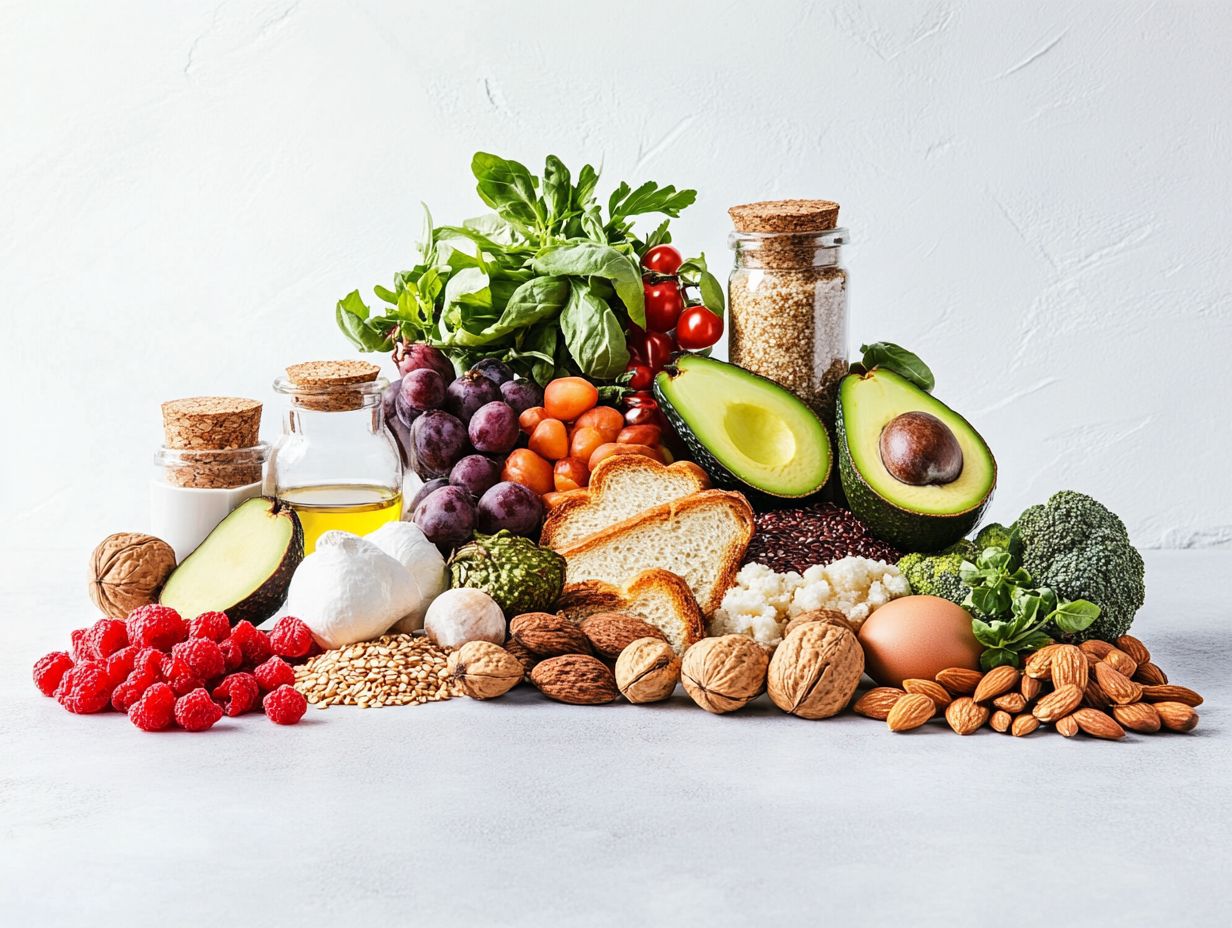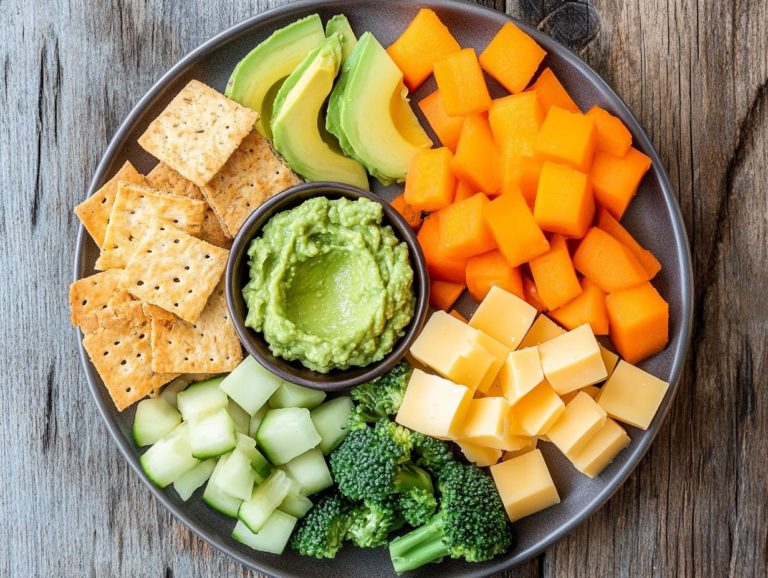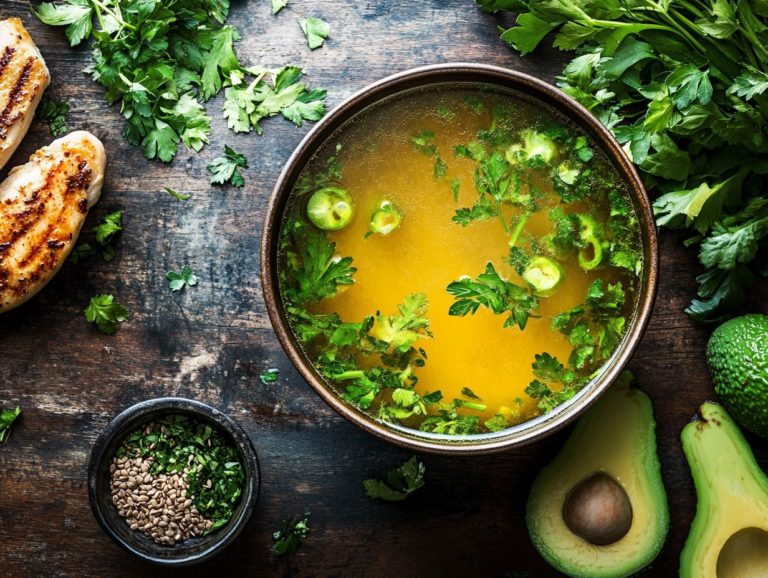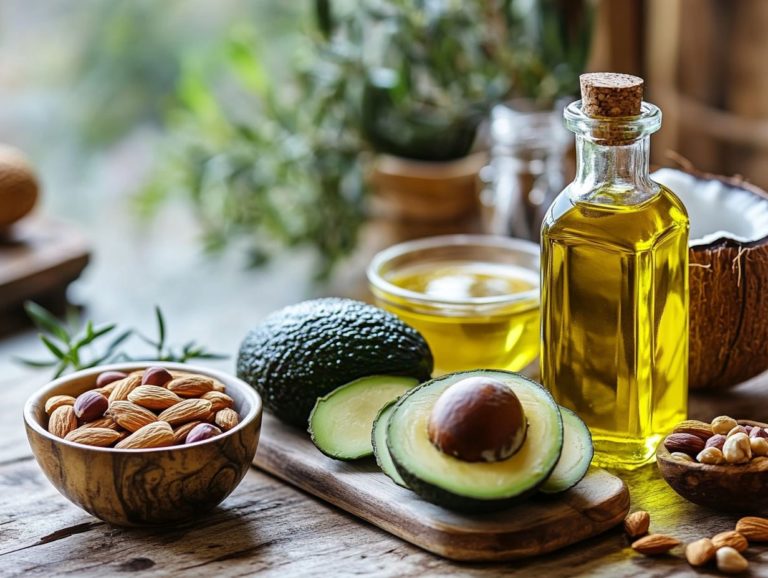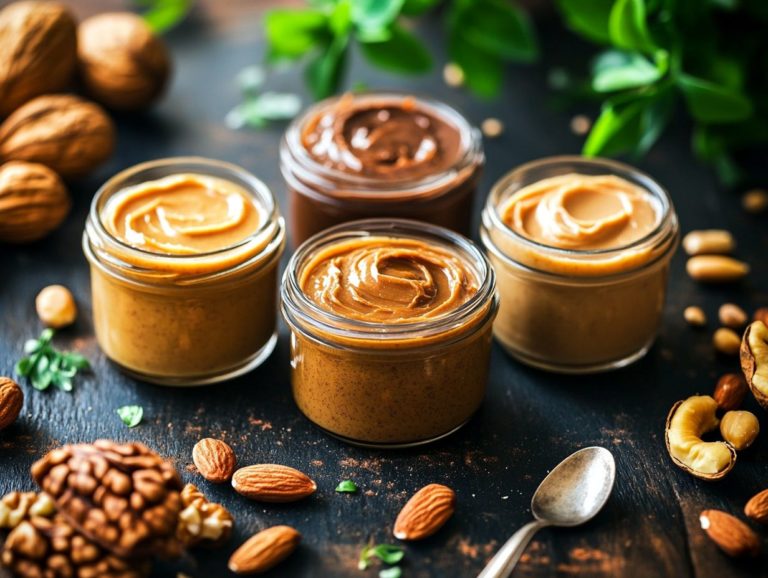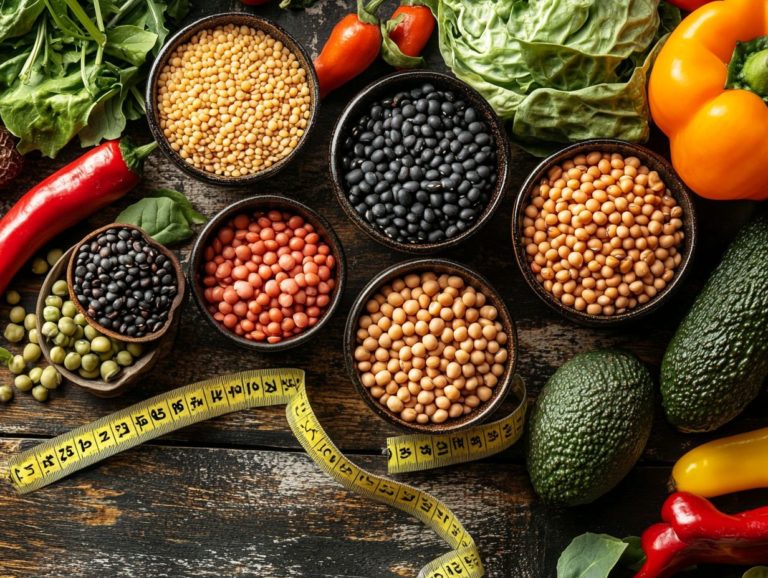Understanding the Glycemic Index for Keto
The glycemic index (GI) is an essential concept for anyone delving into the realm of nutrition, particularly for those embracing a ketogenic diet. By assessing how rapidly foods elevate blood sugar levels, the GI can profoundly influence your health and weight loss journey.
This article delves into the significance of the glycemic index for keto enthusiasts like you and provides guidance on selecting low-GI foods that promote stability and overall wellness.
Uncover delicious options and practical tips that can enhance your keto lifestyle, making it not just healthier but also more effective by prioritizing dietary carbohydrate management.
Contents
- Key Takeaways:
- Understanding the Glycemic Index
- Why Is the Glycemic Index Important for Keto?
- What Are the Benefits of Following a Low Glycemic Index Diet on Keto?
- Benefits of a Low Glycemic Index Diet
- What Are the Best Low Glycemic Index Foods for Keto?
- 1. Non-Starchy Vegetables
- 2. Berries
- 3. Nuts and Seeds
- What Foods Should Be Avoided on Keto Due to High Glycemic Index?
- 3. High Sugar Fruits
- How to Incorporate Low Glycemic Index Foods into a Keto Diet?
- 1. Focus on Whole Foods
- 2. Read Nutrition Labels
- 3. Plan Meals Ahead
- Frequently Asked Questions
- What is the glycemic index (GI)?
- Why is the glycemic index important for those following a keto diet or low GI diet?
- What is considered a low, medium, and high glycemic index (GI)?
- Are all carbohydrates the same when it comes to the glycemic index (GI)?
- What are some examples of low glycemic index foods for those on a keto diet or low GI diet?
- How can I use the glycemic index (GI) for meal planning on a keto diet or low GI diet?
Key Takeaways:
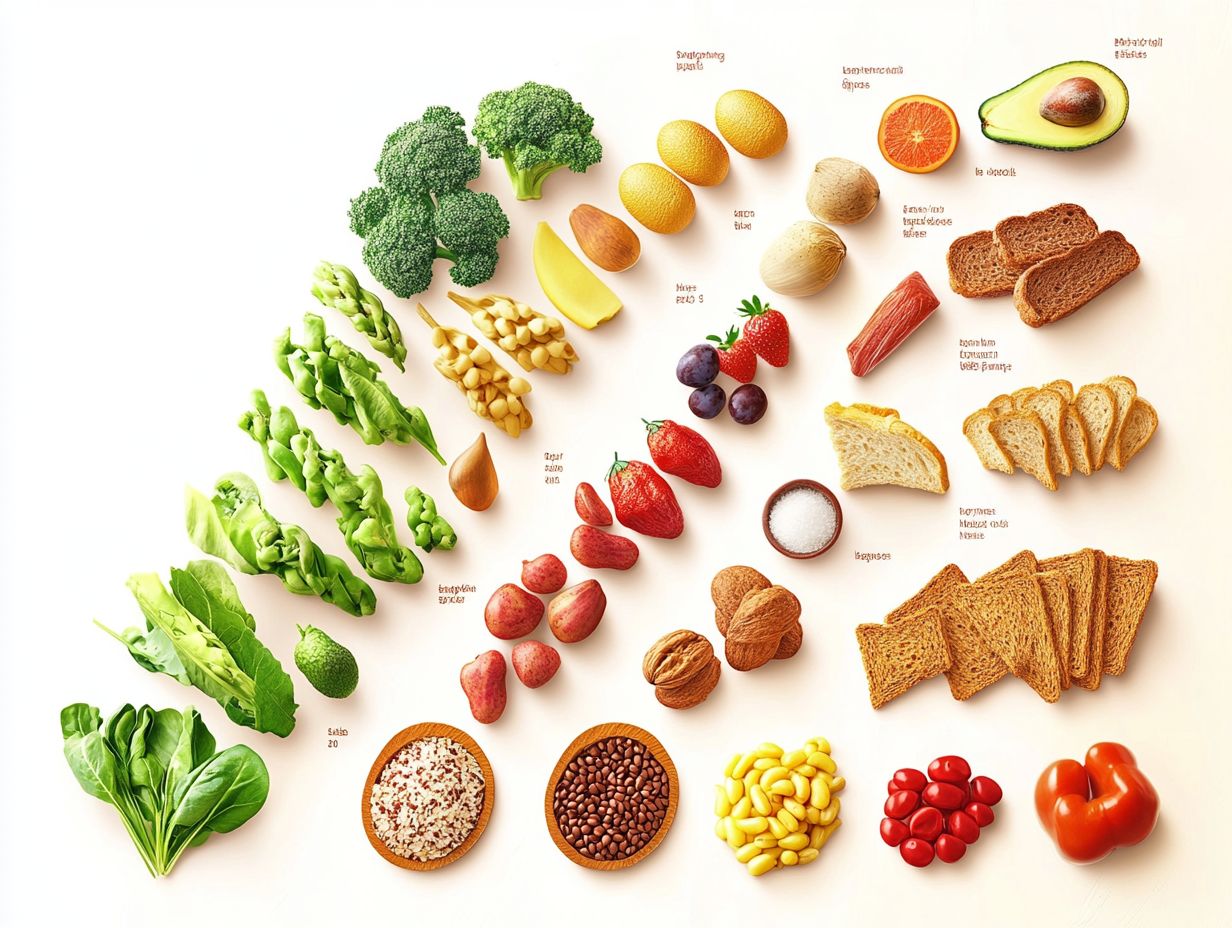
- Incorporating low glycemic index foods into a keto diet can help maintain stable blood sugar levels, support weight loss, and reduce the risk of chronic diseases.
- Non-starchy vegetables, berries, nuts and seeds, and healthy fats are some of the best low glycemic index foods for a keto diet.
- It is important to avoid refined carbohydrates, processed foods, and high sugar fruits on keto due to their high glycemic index.
Understanding the Glycemic Index
The glycemic index (GI) serves as an invaluable resource that ranks carbohydrates according to their impact on blood sugar levels, offering insights into how various foods affect sudden increases in insulin levels and overall metabolic health. Grasping the nuances of this index is essential, especially if you re navigating a low GI or ketogenic diet, as it guides your dietary choices to promote weight loss and enhance well-being.
Foods are classified based on their GI values, with lower numbers signifying a more gradual release of glucose into the bloodstream. This distinction can profoundly influence your approach to carbohydrate management and your broader health outcomes.
This methodology is crucial in categorizing carbohydrates, as it sheds light on the potential health effects of various foods. Items with a lower glycemic index are associated with more stable blood sugar levels and improved overall health.
How Is the Glycemic Index Calculated?
The glycemic index is determined by assessing how much your blood sugar levels rise after consuming a specific carbohydrate-rich food, in comparison to a reference food like glucose or white bread, as described by the American Diabetes Association.
In this assessment, participants are usually healthy individuals who consume a controlled portion of the test food following an overnight fast. Blood samples are collected at regular intervals, typically over a two-hour period, to monitor fluctuations in blood glucose levels.
By contrasting these results with those obtained from the reference food, researchers can assign a glycemic index value to the test food. This methodology is crucial in categorizing carbohydrates, as it sheds light on the potential health effects of various foods.
Why Is the Glycemic Index Important for Keto?
The glycemic index is your secret weapon on a ketogenic diet! It serves as a guiding light for food choices that keep blood sugar levels stable an essential factor for achieving and maintaining ketosis.
Embracing a low-carbohydrate lifestyle requires a thorough understanding of how various foods influence insulin release and blood sugar stability, allowing you to optimize fat burning and promote effective weight loss.
By prioritizing low glycemic index foods, you can savor high-fat delights while minimizing insulin spikes, ultimately boosting your metabolic health and supporting your weight maintenance aspirations.
What Are the Benefits of Following a Low Glycemic Index Diet on Keto?
Adopting a low glycemic index diet within a ketogenic framework presents a multitude of benefits that can profoundly enhance your health outcomes. You’ll experience stable blood sugar levels, effective weight loss, and a diminished risk of chronic diseases.
By prioritizing foods with a low GI, you can relish the advantages of a high-fat, low-carbohydrate diet while minimizing the risk of insulin spikes, which are often precursors to long-term health issues like Type 2 diabetes. This thoughtful dietary adjustment not only aids in maintaining your weight but also promotes a healthier metabolic rate, positioning it as a powerful strategy for anyone striving for improved health.
Ready to take your keto journey to the next level? Try incorporating some low-GI recipes into your meal plan and share your favorite low-GI foods in the comments below!
Benefits of a Low Glycemic Index Diet
1. Helps Maintain Stable Blood Sugar Levels
One of the primary advantages of embracing a low glycemic index diet lies in its remarkable ability to help you maintain stable blood sugar levels, a vital aspect of overall metabolic health. Effective energy utilization is closely linked to this stability.
By integrating foods that release glucose slowly into your bloodstream, you can significantly minimize the risks associated with blood sugar spikes and insulin resistance. Insulin, the hormone tasked with regulating blood glucose levels, operates more efficiently when you choose foods with a low glycemic index.
For those of you following ketogenic diets, which emphasize a low carbohydrate intake, grasping how a low GI approach can enhance your regimen is crucial. Incorporating leafy greens, legumes, and whole grains allows you to enjoy beneficial nutrients while being mindful of your carbohydrate consumption.
You can also further optimize your blood sugar management by strategically timing your meals and focusing on combination foods such as pairing proteins with low GI carbohydrates.
2. Supports Weight Loss on Keto
Embracing a low glycemic index diet can significantly enhance your weight loss journey while on a ketogenic plan. This approach prioritizes foods that promote satiety, ultimately helping you reduce overall food intake and manage blood sugar control.
By managing hunger hormones like ghrelin and leptin key players in appetite regulation you’ll find that your cravings become more manageable. When you opt for low GI foods, you often enjoy stabilized blood sugar levels, which results in fewer cravings and a lower caloric intake throughout the day.
The synergy between low GI and ketogenic foods is particularly powerful; it encourages effective fat utilization, especially during ketosis, when your body shifts its primary energy source from carbohydrates to stored fat.
To seamlessly incorporate low GI foods into your keto lifestyle, choose options such as leafy greens, nuts, and seeds, along with lean proteins and healthy fats. This way, your meals remain satisfying without causing spikes in glucose levels, ensuring better management of your dietary carbohydrate intake.
Take, for instance, a hearty salad topped with avocado and grilled chicken. Not only is it low in carbohydrates, but it also provides sustained energy and a feeling of fullness that keeps you on track.
3. Reduces Risk of Chronic Diseases
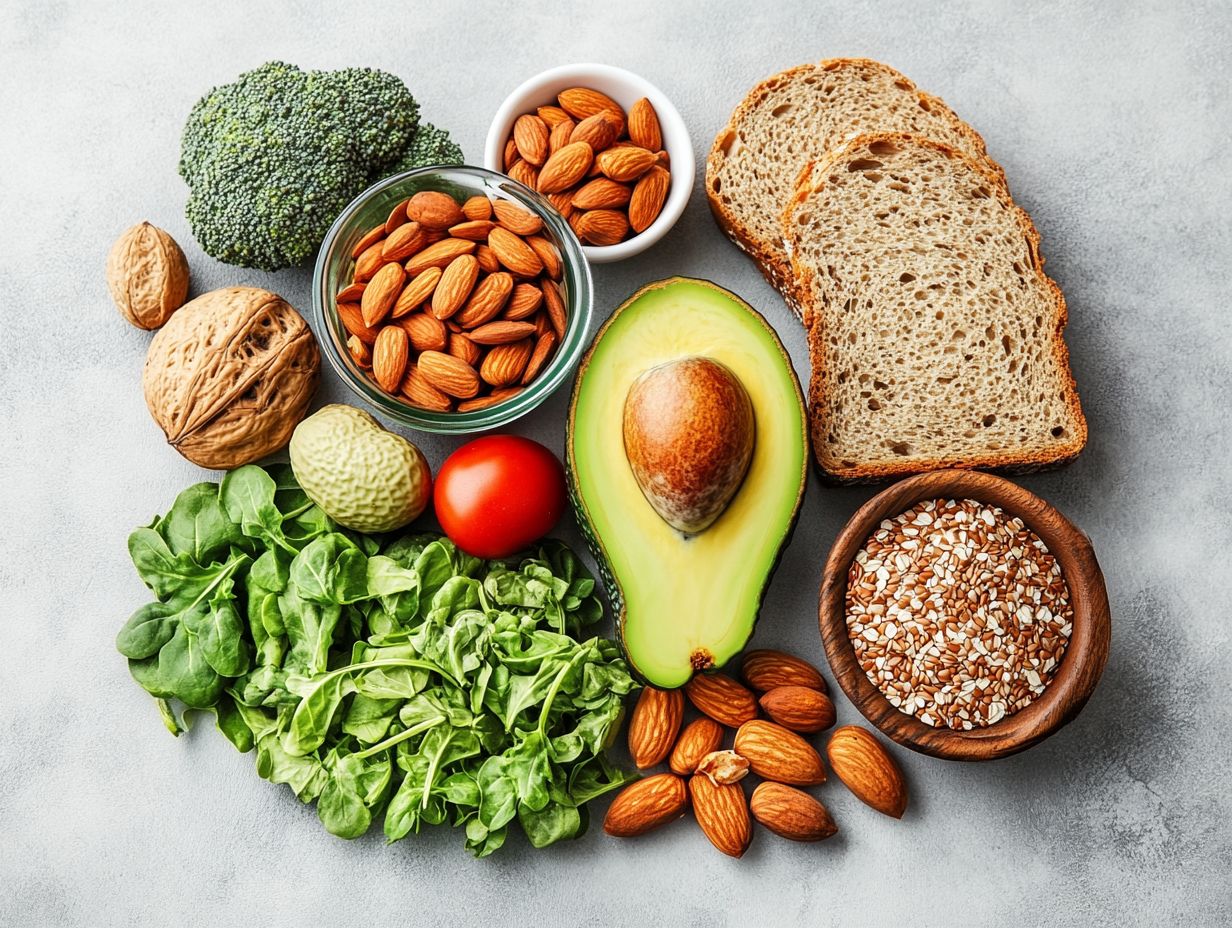
Reducing the glycemic load of your diet through a low GI approach can significantly mitigate the risk of chronic diseases, including Type 2 diabetes and cardiovascular disorders, as emphasized by Campbell University School of Osteopathic Medicine.
Recent studies indicate that individuals who regularly indulge in high glycemic index foods such as white bread, sugary snacks, and certain processed cereals are at a higher risk of developing these conditions. In contrast, when you adopt a low GI diet that emphasizes whole grains, legumes, and non-starchy vegetables, you not only stabilize your blood sugar levels but also enhance your insulin sensitivity and manage your metabolic rate more effectively.
Research published in reputable journals has demonstrated that low GI diets are associated with reduced inflammation and improved overall metabolic health. By embracing this dietary shift, you can dramatically lower your odds of chronic illness and foster long-term wellness, highlighting the significant impact that your food choices can have on your health outcomes. Start making these smart food choices today to protect your health and transform your life!
What Are the Best Low Glycemic Index Foods for Keto?
When you embark on a ketogenic diet, it’s essential to incorporate the best low glycemic index foods to achieve your health goals while maintaining ketosis. Foods like non-starchy vegetables, berries, and healthy fats not only deliver vital nutrients but also help keep your blood sugar levels stable, making them perfect choices for anyone aiming for weight loss and enhanced well-being.
Consider integrating avocados, olive oil, and legumes like kidney beans as part of your regular meals. These choices align perfectly with the principles of a low-carbohydrate diet and provide significant health benefits.
1. Non-Starchy Vegetables
Non-starchy vegetables rank among the finest low glycemic index foods for your ketogenic diet, offering essential nutrients without causing significant fluctuations in your blood sugar levels.
Think of options like leafy greens such as spinach and kale, cruciferous veggies like broccoli and cauliflower, and vibrant bell peppers and zucchini. You can also add beans like kidney beans and fruits like avocado to further enhance your diet’s nutritional profile.
These vegetables are bursting with vitamins and minerals, serving as nutritional powerhouses. They are also abundant in dietary fiber, which is vital for digestive health and can help you feel fuller throughout the day.
By weaving these vegetables into your meals be it in fresh salads, flavorful stir-fries, or as delightful side dishes you can elevate your dining experience without the worry of insulin spikes. The variety of flavors and textures that these non-starchy selections contribute not only makes your meals healthier but also adds impressive versatility to your culinary repertoire.
2. Berries
Berries are a fantastic low glycemic index option, offering sweet flavors without significantly impacting your blood sugar levels. Opt for varieties like strawberries, blueberries, and raspberries to enjoy their rich antioxidants and fiber content.
Berries, including strawberries, blueberries, and raspberries, are some of the best low glycemic index fruits you can savor on a ketogenic diet, thanks to their low carbohydrate content and impressive antioxidant levels. These fruits help keep your blood sugar stable and promote overall improved health.
Beyond being a delightful treat, these vibrant fruits are brimming with nutrients that can help you regulate blood sugar levels and enhance your overall health. For example, blueberries are celebrated for their potential to improve insulin sensitivity, while strawberries boast anti-inflammatory properties that support cardiovascular well-being. Therefore, they are highly recommended by health organizations like the American Diabetes Association.
To seamlessly incorporate these nutritious berries into your daily meals, consider these simple options:
- Blend them into refreshing smoothies!
- Add them to your morning yogurt for a tasty breakfast!
- Sprinkle them over salads to add a refreshing twist!
For a quick snack, enjoy berries raw, or pair them with nuts for a satisfying and healthful option.
3. Nuts and Seeds
Nuts and seeds aren t just tasty treats; they re also low glycemic index champions that deliver healthy fats, protein, and a treasure trove of nutrients perfectly suited for your ketogenic lifestyle. These foods are excellent for weight maintenance and supporting a healthy metabolism.
Packed with omega-3 and omega-6 fatty acids, options like walnuts, flaxseeds, and chia seeds can help you combat inflammation and enhance your heart health. Almonds and macadamia nuts are particularly rich in monounsaturated fats, which keep you feeling full and help you maintain ketosis. It’s important to keep an eye on portion sizes generally sticking to about a handful since those calories can sneak up on you. Including these in your dietary carbohydrate plan can contribute substantially to weight loss.
If you’re looking to weave these nutritional powerhouses into your meals, consider tossing a sprinkle of pumpkin seeds into your salads, blending nut butter into your smoothies, or using ground almonds in your baking. These simple additions can elevate your dishes while keeping you firmly on your low-carb path.
4. Healthy Fats
Healthy fats, such as those found in avocados, olive oil, and hard cheese, are essential low glycemic index foods that can elevate your ketogenic lifestyle. They provide energy without spiking your blood sugar levels, which is crucial for weight management and overall health.
These fats are energy-dense and play a crucial role in maintaining ketosis the metabolic state where your body efficiently burns fat for fuel instead of relying on carbohydrates. By incorporating healthy fats into your daily meals, you’ll find yourself feeling satiated, which can help curb those pesky cravings often linked to carb-heavy diets. Additionally, these high-fat foods provide a stable energy source throughout the day.
For example, drizzling olive oil over your salads or saut ing vegetables in coconut oil enhances both flavor and nutrient delivery. Planning meals rich in nuts, seeds, and fatty fish maximizes your health benefits and makes it easier to stay in ketosis.
This strategic incorporation of healthy fats not only supports your weight management goals but also promotes overall well-being. The ketogenic approach becomes both sustainable and enjoyable. According to experts at Campbell University School of Osteopathic Medicine, such dietary modifications are essential for long-term health benefits.
What Foods Should Be Avoided on Keto Due to High Glycemic Index?
Steering clear of foods with a high glycemic index is essential in a ketogenic diet. These foods can trigger spikes in your blood sugar and insulin levels, ultimately undermining your weight loss goals and metabolic health. Keeping track of your Hemoglobin A1c is crucial as it provides insights into your average blood sugar levels over time.
Watch out! High GI foods, such as refined carbohydrates and processed items, can disrupt your state of ketosis, making it difficult to achieve the health outcomes you desire. By understanding which foods to eliminate, you can effectively maintain a low carbohydrate diet while enhancing your overall well-being.
1. Refined Carbohydrates
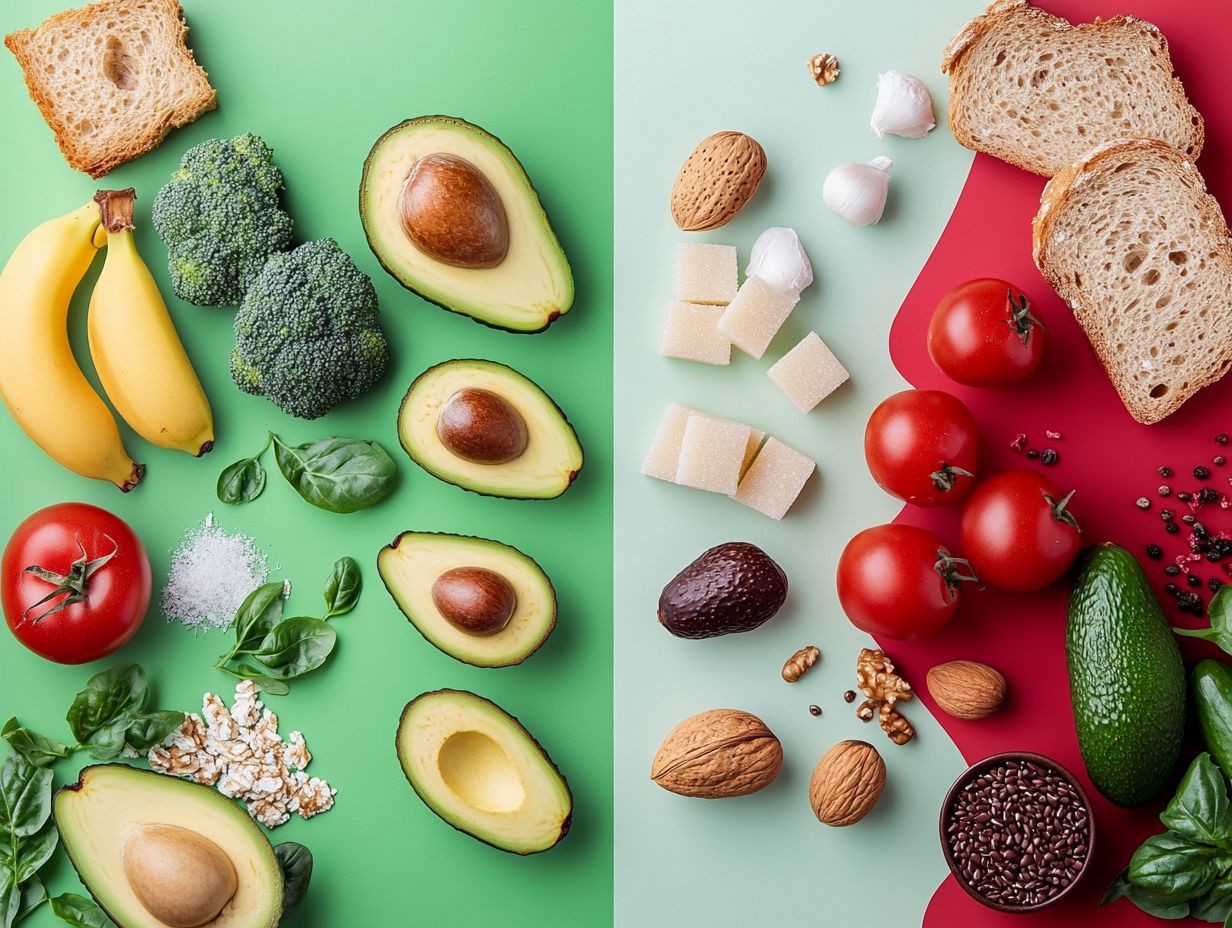
Refined carbohydrates, such as white bread, pastries, and sugary snacks, are high glycemic index foods you should strictly avoid on a ketogenic diet. They can wreak havoc on your blood sugar levels.
These foods undergo extensive processing, stripping away their natural fiber and nutrients, making them quickly digestible and leading to rapid spikes in insulin levels. Such spikes can result in erratic energy levels and heightened hunger, undermining your ketogenic goals.
When you consume high-carb foods frequently, insulin the hormone responsible for regulating blood sugar can become overworked, paving the way for insulin resistance, a condition often associated with obesity and type 2 diabetes.
Instead, consider opting for whole grains over white bread and choosing natural low-carb snacks instead of pastries. These choices can significantly contribute to better metabolic health and help maintain ketosis, essential for efficiently burning fat.
2. Processed Foods
Processed foods are often laden with added sugars and unhealthy fats, making them high glycemic index options that you should definitely avoid on a ketogenic diet. These foods can have serious health implications related to obesity and cardiovascular diseases.
These foods can trigger spikes in your blood sugar levels, leading to increased cravings that ultimately sabotage your weight management efforts. With their lengthy lists of artificial ingredients, they can also contribute to inflammation and chronic health issues.
Instead, embrace whole, nutrient-dense foods like avocados, leafy greens, and high-quality meats as part of your ketogenic lifestyle. These alternatives support ketosis and deliver essential vitamins and minerals that promote overall well-being.
By prioritizing these healthier options, you can enjoy satisfying meals that nourish you without compromising your health.
In summary, focusing on healthy fats while avoiding high glycemic index foods is key to maintaining a successful ketogenic lifestyle. Make informed choices, and savor the journey to better health!
3. High Sugar Fruits
Certain fruits, particularly those higher in sugar like bananas and grapes, fall into the category of high glycemic index (GI) foods. These can disrupt your state of ketosis, so it s wise to limit them on a ketogenic diet.
Instead, consider integrating low glycemic fruits into your low-carbohydrate diet for better results. While these fruits are undeniably delicious and packed with nutrients, they can trigger spikes in blood sugar levels, complicating your efforts if you re committed to a strict carb-restricted lifestyle.
For example, bananas typically have a glycemic index (GI) score of around 51, while grapes hover around a GI of approximately 46. On the other hand, choosing fruits with lower glycemic index values, such as berries like strawberries and raspberries, can be a game changer for you.
With GI scores generally below 40, these options satisfy your sweet cravings while ensuring stable blood sugar levels and supporting your metabolic health.
How to Incorporate Low Glycemic Index Foods into a Keto Diet?
Incorporating low glycemic index foods into your ketogenic diet requires thoughtful meal planning. This helps achieve a harmonious balance of nutrients while keeping your body in ketosis.
By prioritizing foods with a low GI, you can savor a delightful variety of flavors and textures, all while promoting stable blood sugar levels and enhancing your metabolic health. For those following a keto diet, understanding glycemic index on keto is crucial. Embracing this dietary approach opens the door to a world of nourishing foods that support your health journey.
This approach aligns with the principles of a low GI diet and offers numerous health benefits. It encourages you to embrace whole foods, such as vibrant vegetables, nourishing healthy fats, and low-sugar fruits, which are crucial for anyone aiming for weight loss and improved overall health.
1. Focus on Whole Foods
Focusing on whole foods is an essential strategy for incorporating low glycemic index options into your ketogenic diet. This allows you to emphasize nutrient-dense foods that truly nourish your body.
This method of dietary intervention can lead to significant health improvements. By opting for whole foods, you help maintain stable blood sugar levels and gain access to essential vitamins and minerals that support your overall health.
For example, vegetables like spinach, broccoli, and kale are outstanding low-GI choices that align seamlessly with keto principles. They offer fiber and antioxidants without the insulin spikes associated with processed alternatives.
To fully leverage the benefits of whole foods, consider selecting organic produce whenever possible, as they are free from harmful pesticides. Meal prepping in advance can also be a game changer, ensuring that healthy options are readily available.
This makes it far easier for you to resist the allure of convenience foods.
2. Read Nutrition Labels
Reading nutrition labels is essential if you’re aiming to incorporate low glycemic index foods into your ketogenic diet. It s your secret weapon for identifying hidden sugars and high GI ingredients lurking in packaged foods.
As you examine nutrition labels, pay close attention to several key factors. First, check the carbohydrate content; ideally, it should be low to align with the principles of a ketogenic diet. Be cautious of the section on added sugars, which can be quite misleading.
Many products contain various forms of sugar that can sneakily push you over your carbohydrate limits. Be cautious of artificial ingredients as they may not align with a healthy diet.
Also, keep an eye on the glycemic index information. Products with a high GI can trigger spikes in blood sugar, which is the opposite of what you want when pursuing a low GI lifestyle.
When choosing snacks, look for options like nuts or certain vegetables. These maintain low carbohydrate levels while also boasting a lower glycemic index, ensuring they fit seamlessly within both dietary frameworks.
This approach is vital for anyone looking to follow a low-carbohydrate diet effectively.
3. Plan Meals Ahead
Planning your meals ahead is an essential strategy for seamlessly incorporating low glycemic index foods into your low GI diet and ketogenic diet. This approach helps you control what you eat while ensuring you stick to your dietary goals. Such dietary interventions can lead to weight loss and improved health.
Craft a weekly meal plan to meet your nutritional targets. This approach allows you to enjoy a delightful variety of meals that support your health goals. Choosing low GI options helps stabilize your blood sugar levels, making it easier to fend off cravings and maintain steady energy throughout the day. This dietary change also helps manage glucose levels and avoid insulin peaks.
As you plan, consider adding meals like:
- Zoodles topped with avocado pesto for a refreshing lunch
- A hearty salad with grilled chicken and roasted vegetables for a satisfying dinner
Strategic grocery shopping and prep sessions can save you precious time during hectic weekdays, paving the way for a more relaxed lifestyle. Simple snacks such as:
- Celery sticks with almond butter
- Hard-boiled eggs
- Low GI fruits like berries
These tasty snacks will crush your hunger and fit perfectly into your keto lifestyle! They align with your keto principles and aid in weight maintenance.
Frequently Asked Questions
What is the glycemic index (GI)?
The glycemic index (GI) is a numerical scale that ranks carbohydrates based on how quickly they raise blood glucose levels. It measures how much a specific dietary carbohydrate increases blood sugar within a two-hour period compared to pure glucose, which has a GI of 100. This is particularly important for those with Type 2 diabetes, as endorsed by the American Diabetes Association, to manage their Hemoglobin A1c levels.
Why is the glycemic index important for those following a keto diet or low GI diet?
The keto diet focuses on limiting carbohydrates and promoting a state of ketosis, where the body burns high-fat foods for energy instead of sugar. Understanding the glycemic index can help individuals on the keto diet and low GI diet make informed decisions about which carbohydrates to consume to maintain ketosis, avoid blood sugar spikes, and understand the health implications of their choices.
What is considered a low, medium, and high glycemic index (GI)?
A GI of 55 or less is considered low, 56-69 is medium, and 70 and above is high. Foods with a low GI are digested more slowly, resulting in a slower rise in blood sugar levels. On the other hand, foods with a high GI are digested quickly, causing a rapid increase in blood sugar. To optimize metabolic rate and insulin control, it is essential to focus on low GI foods.
Are all carbohydrates the same when it comes to the glycemic index (GI)?
No, not all carbohydrates are the same. The type of dietary carbohydrate, as well as the cooking method, can affect the glycemic index. For example, cooked carrots have a higher GI than raw carrots, and white bread has a higher GI than whole grain bread. Foods like legumes, whole grains, vegetables, fruits, and whole foods in general usually have a lower GI.
What are some examples of low glycemic index foods for those on a keto diet or low GI diet?
Some examples of low GI foods include non-starchy vegetables, nuts and seeds, berries, avocados, legumes, and whole grains. These can be great options for those on a keto diet as they typically have a lower impact on blood sugar levels and can help maintain ketosis. Including foods like kidney beans, hard cheese, and using healthy fats like olive oil can further complement your diet.
How can I use the glycemic index (GI) for meal planning on a keto diet or low GI diet?
When meal planning for a keto diet or low GI diet, it can be helpful to choose low GI carbohydrates and combine them with healthy fats and proteins to help maintain stable blood sugar levels and promote ketosis. Additionally, keeping track of the GI of different foods can help with making informed choices when grocery shopping and dining out. Institutions like the Campbell University School of Osteopathic Medicine often recommend such dietary interventions for managing long-term health.

